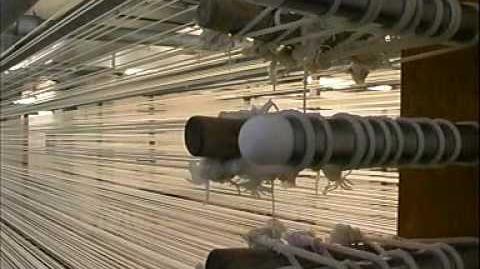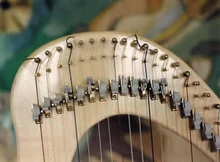
How natural gut is made
Overview[]
Early harps were likely strung with gut. This type of string is formed from the intestines of an animal, usually a sheep or goat, but occasionally from cattle, hogs, horses, mules or donkeys. The contemporary term “catgut” does not reflect the use of the cat’s intestines to make gut strings. Gut strings are often preferred by classical and baroque musicians because they give a rich, warm tone that can withstand high string tension. [1]
Gut and horsehair strung harps were common during the Middle Ages. It is known that harps strung with brass were also used in Ireland and Scotland during the Middle Ages and up to the time of their virtual disappearance in the late 18th century. Welsh harps during the late Middle Ages and early Modern Age were typically strung with horsehair and were called telyn, stemming from an Irish word meaning the humming or buzzing of a bee. These harps reportedly produced a low humming sound, quite different than the resonance of wire-strung harps, which were known for their bell-like, tinkling sounds (for an interesting look at the attempted reproduction of these harps see Project Telyn Rawn).

Wikipedia. Keltische Harfe mit Halbtonklappen. Retrieved from WikiMedia
Nylon was invented in 1930 by DuPont, and the development of nylon filament strings for stringed instruments followed in the 1940s. Today harps are made with gut, nylon, and metal strings (steel wound with copper, phosphor bronze, brass, silver, and gold). Several alternatives to gut strings have also been developed, such as Nylgut or synthetic gut, also known as fluorocarbon.
“The string material is determined by harmonicity … and “feel”. Harmonicity requires that the string be strong, heavy enough, but not stiff. “Feel” is how hard the player has to pull to move the string centre a given amount before release; it should be large enough that the strings do not touch, and not vary too much from string to string … Gut is mechanically similar to nylon but has a warmer tone for the mid-register. Practical reasons make the harp neck a double curve … so much heavier strings are needed for the low register. Nylon/gut strings would have to be very thick here, very inharmonic, and the feel would be so small that the strings would interfere with each other. Steel wrapped with helical copper wire is used” (Waltham, 2005).
Harp strings vary in diameter as well. Each harp-maker uses particular gauges to aid in producing sound. Smaller gauges are usually used in the treble, with larger gauges in the bass.
Harps, up until the late 1500s/early 1600s, were usually made with a single row of strings. The first cross-strung (multiple-row) harp is believed to have been created in the late 16th century in Spain and was known as the “Arpa de dos ordenes”. Its identity as an instrument was established as soon as the early 17th century and was used in both liturgical and secular music.[2]
Today both single course and multi-course harps are made, with a full range of string material.
Types of Harp Strings[]
- Flurocarbon. This section needs more information. Can you help contribute?
- Gut (Concert). This section needs more information. Can you help contribute?
- Gut (Folk). This section needs more information. Can you help contribute?
- Nylon. This section needs more information. Can you help contribute?
- Wire (Bronze). This section needs more information. Can you help contribute?
- Wire (Gold). This section needs more information. Can you help contribute?
- Wire (Silver). This section needs more information. Can you help contribute?
- Wire (Steel). This section needs more information. Can you help contribute?
Further Reading[]
- Strings of Gold
- Precious Metal Strings on the Wire Strung Harp
- String Theory
- Video: All About Strings
- Changing/Replacing Strings
References[]
Note about this article. Some of this content has been copy-pasted from Peggy Coates' website dorveille.com The website has disappeared, but the content remains on the internet archives. Attempts have been made to get in touch with the original author, but have been unfruitful. Should Peggy come across this content, please get in touch with @harpwiki!
- ↑ Wikipedia. Catgut. Retrieved from http://en.wikipedia.org/wiki/Catgut
- ↑ Wikipedia (n.d.). Cross-Strung Harp. Retrieved from http://en.wikipedia.org/wiki/Cross-strung_harp
